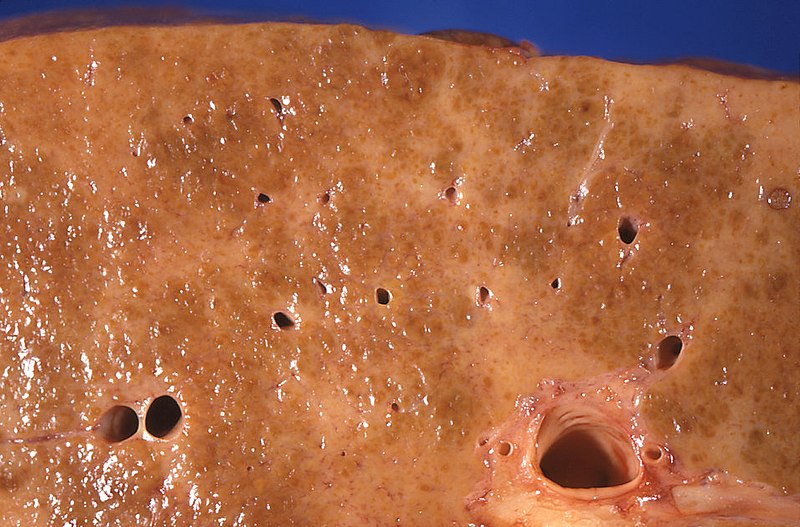Playlist
Show Playlist
Hide Playlist
End-stage Liver Disease with Case
-
Slides Gastroenterology 13 Liver Pt3 End Stage Liver Disease.pdf
-
Reference List Gastroenterology.pdf
-
Download Lecture Overview
00:00 Let's move to our next case. 00:03 A 53-year-old man is seen in clinic for follow-up of his hepatitis C cirrhosis. 00:08 In the past year, his ascites has worsened, now requiring weekly large volume paracentesis. 00:15 He is adherent his low sodium diet and takes maximal doses of furosemide and spironolactone. 00:22 Vitals are notable for blood pressure of 95/62 mmHg but otherwise normal. 00:27 His physical exam shows jaundice, spider angiomata, abdominal distention with ascites and splenomegaly. 00:34 No asterixis is noted. 00:36 His model for end-stage liver disease or MELD score is 25. 00:41 So what is the best next step in management? So he now has worsening decompensated cirrhosis with ascites that is refractory to both diuretics and low sodium diet. 00:55 And his MELD score is quite high. 00:57 We'll discuss what that means next. 01:01 So, the first question to consider is, is he a candidate for TIPS? As you recall, TIPS is a procedure we can sometimes do to manage ascites that’s refractory to medical management. 01:13 The next question is, should he be referred for transplantation? So, we'll consider these things when we answer this question. 01:22 Let's first discuss what these different risk calculators are. 01:25 So with cirrhosis we have two systems for determining patient's prognosis. 01:31 The first is the MELD score and the second is the Child-Pugh score. 01:35 Both of them can help you predict mortality or survival rate, and risk of surgery. 01:42 They take into account slightly different variables and when you calculate your score for your patient, This threshold's to know, or if your MELD is greater than or equal to 15, at this point, you should refer that patient for a transplant evaluation because we know that their mortality becomes quite high at this point. 02:01 There is a newer version of the MELD score called the MELD-Na score, which incorporates the patient's sodium level along with the usual factors in the MELD score. This is because hyponatremia often occurs in patients with cirrhosis, and the more severe the hyponatremia, the more severe the cirrhosis. A lower sodium level correlates with higher mortality among patients with cirrhosis. The MELD-Na score is increasingly being used worldwide to allocate liver transplants. 02:29 On the other hand, Child-Pugh scores correlate to a different tyoe of class and we know that in one year, those with class A Child-Pugh may have a 100% survival rate whereas once you have progressed to class C, you have only a 45% chance of surviving in one year. 02:47 So we spoke about liver trasnplantation. 02:49 Liver transplantation evaluation is very complicated. 02:53 There are many different contraindications to receiving a liver transplantation and every transplant center may have its own list of criteria. 03:02 Here is a brief general list that you may think of. 03:06 So, patients who have severe cardiopulmonary disease, uncontrolled infections or cancer outside of the liver, severe psychiatric illness or substance dependence, inability to comply in the past with medical management or a lack of social support or advanced age. 03:23 All of these factors may be limiting in your consideration for receiving a liver transplantation. 03:32 So now let's go back to our case. 03:34 Our 53-year-old man with now worsening decompensated cirrhosis. 03:38 We know his ascites has been refractory to both diuretics and sodium restriction and his MELD score is quite elevated. 03:46 So, now that we know his MELD score is high, above the threshold of 15, we know the next step is to refer for liver transplantation. 03:55 If you thought about the TIPS procedure, this is actually contraindicated when a MELD score higher than 15-18 due to very high risk of mortality associated with the procedure. 04:07 Thank you very much for your attention today.
About the Lecture
The lecture End-stage Liver Disease with Case by Kelley Chuang, MD is from the course Disorders of the Hepatobiliary Tract.
Included Quiz Questions
Which of the following is contraindicated in a patient with decompensated cirrhosis and a MELD score of >15?
- Transjugular intrahepatic portosystemic shunt (TIPS)
- Liver transplantation
- Diuretics
- Low-sodium diet
Which of the following is a contraindication to liver transplantation?
- Substance dependence
- Fulminant hepatic failure
- Hepatocellular carcinoma
- Hepatic encephalopathy
- Adequate social support
Customer reviews
5,0 of 5 stars
| 5 Stars |
|
5 |
| 4 Stars |
|
0 |
| 3 Stars |
|
0 |
| 2 Stars |
|
0 |
| 1 Star |
|
0 |




